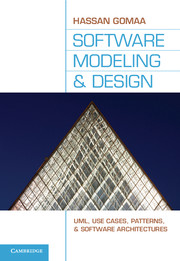Book contents
- Frontmatter
- Contents
- Preface
- Annotated Table of Contents
- Acknowledgments
- PART I Overview
- PART II Software Modeling
- PART III Architectural Design
- PART IV Case Studies
- 21 Client/Server Software Architecture Case Study
- 22 Service-Oriented Architecture Case Study
- 23 Component-Based Software Architecture Case Study
- 24 Real-Time Software Architecture Case Study
- Appendix A Catalog of Software Architectural Patterns
- Appendix B Teaching Considerations
- Glossary
- Answers to Exercises
- Bibliography
- Index
22 - Service-Oriented Architecture Case Study
from PART IV - Case Studies
Published online by Cambridge University Press: 05 June 2012
- Frontmatter
- Contents
- Preface
- Annotated Table of Contents
- Acknowledgments
- PART I Overview
- PART II Software Modeling
- PART III Architectural Design
- PART IV Case Studies
- 21 Client/Server Software Architecture Case Study
- 22 Service-Oriented Architecture Case Study
- 23 Component-Based Software Architecture Case Study
- 24 Real-Time Software Architecture Case Study
- Appendix A Catalog of Software Architectural Patterns
- Appendix B Teaching Considerations
- Glossary
- Answers to Exercises
- Bibliography
- Index
Summary
The Online Shopping System case study is a highly distributed World Wide Web–based system that provides services for purchasing items such as books or clothes. The solution uses a service-oriented architecture with multiple services; coordinator objects are used to facilitate the integration of the services. In addition, object brokers are used to provide service registration, brokering, and discovery. Services include a catalog service, an inventory service, a customer account service, a delivery order service, an email service, and a credit card authorization service.
The problem is described in Section 22.1. Section 22.2 describes the use case model for the Online Shopping System. Section 22.3 describes the static model, which includes the system context model that depicts the boundary between the system and the external environment. This section also describes the use of broker technology in this system before going on to describe static modeling of the entity classes. Section 22.4 describes how to structure the system into objects. Section 22.5 describes dynamic modeling, in which communication diagrams are developed for each of the use cases. Section 22.6 describes the design model for the system, which is designed as a layered architecture based on the Layers of Abstraction pattern consisting of services and components.
PROBLEM DESCRIPTION
In the Web-based Online Shopping System, customers can request to purchase one or more items from the supplier. The customer provides personal details, such as address and credit card information. This information is stored in a customer account.
Information
- Type
- Chapter
- Information
- Software Modeling and DesignUML, Use Cases, Patterns, and Software Architectures, pp. 424 - 452Publisher: Cambridge University PressPrint publication year: 2011
